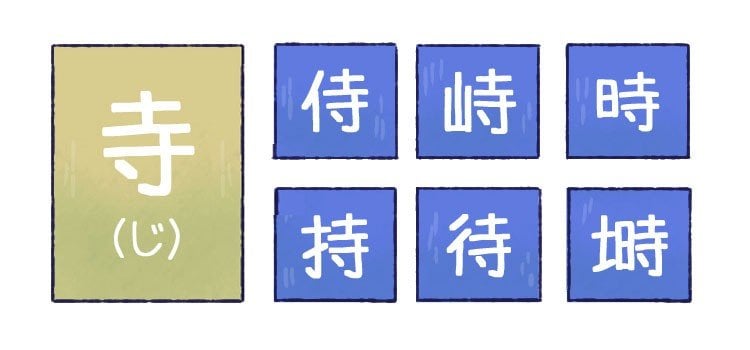Did you know that in the Japanese language, several ideograms can have the same pronunciation because of a small phonetic component within them? This component is called keiseimoji (形声文字) and is present in about 70% of Japanese ideograms. Knowledge of this phonetic component can help you understand and discover the reading of most Japanese ideograms.
These phonetic components can be radicals with sound or other kanji that function as radicals. This phonetic component is usually found on the right side of an ideogram and sometimes at the bottom. The phonetic component only indicates the Chinese reading. ON YOMI.
Why does Japanese have so many Kanji with the same reading? Japanese is a language with few phonemes that adopted the Chinese ideograms which use a tonal language. Basically, Japanese inherited all the tonal readings from Chinese, but without the tonality.
Knowing how to read a phonetic component will help us identify most of the on yomi readings present in a kanji. Read also: Bushu - Radicals - Kanji structures and their variants
Índice de Conteúdo
Concept of Phonetic Components
Japanese kanji characters are often formed by a combination of elements. One of these elements is the phonetic component (音符, onpu), which generally indicates how the kanji is read. The phonetic component is not always accurate, but it provides helpful clues.
Practical examples
- Kanji: 時 (tempo)
- Phonetic Component: 寺
- Reading: Ji
- Note: The kanji 寺 (temple) is read as "ji". The phonetic component "寺" in 時 is also read as "ji". Therefore, 時 is read as "ji", which means "time".
- Kanji: 湖 (lake)
- Phonetic component: 古
- Reading: Ko
- Note: The kanji 古 (ancient) is read as "ko". The phonetic component "古" in 湖 also suggests the reading "ko", meaning "lake".
- Kanji: 保 (protect)
- Phonetic Component: 呆
- Reading: Ho
- Note: Although the kanji 呆 (surprise) is not common, its reading "ho" is shared with 保, where it acts as a phonetic component.
How to Use Phonetic Components in Learning
IdentificationStart by identifying the phonetic component in a kanji. This is usually a smaller component within the kanji that you may already know from elsewhere.
AssociationAssociate this component with a kanji whose reading you already know. For example, if you know that 寺 is read as "ji", you can use this to remember the reading of 時.
Practical exercisesPractice writing or revising kanji that have the same phonetic component. For example, create a list of kanji that contain 寺 as a phonetic component and practice them together.
Attention to ExceptionsBe aware that the phonetic component is not always a fail-safe guide. Some kanji may have different readings than expected. It is important to balance this technique with other forms of learning.
Use of ResourcesUse resources that emphasize the phonetic components of kanji, such as textbooks or apps that highlight these connections.
What is a kanji with a phonetic component?

You may still have been confused in understanding what is components or phonetic compound that make up a kanji. The best way to understand what I'm talking about is to see it in practice. Pay close attention to the image below:
Here we find the ideogram 寺 which means buddhist temple. His Japanese reading (KUN YOMI) is [will have] while the Chinese reading (ON YOMI) is [ji]. All other kanji in the image have the 寺 on the right side. This makes all the ideograms in the image have the same Chinese reading or on yomi as [ji].
It should be noted that this rule is not absolute. Many Japanese ideograms have more than one Chinese reading. Some kanji also gain Chinese reading with dakuten. As an example, an ideogram with the reading か can sometimes also have the reading が. It is impossible to determine this without knowing the ideogram or at least the words it forms. This reading of dakuten exists to make the pronunciation of the words formed by the ideogram more beautiful.
Therefore, you should keep in mind that there are thousands of kanji, some are composed of one or more components (radicals or kanji). Others have zero or more than one Chinese reading (on yomi). With that in mind, you can start to assimilate some ideograms through their components and discover their reading. It's not an easy process, you need to have a good knowledge of Japanese to be able to read ideograms and words formed by radicals/kanji with your Chinese readings.
The article is still halfway through, but we recommend also reading:
Kanji with the same readings ON YOMI
The table below shows examples of ideograms that have a phonetic component (or a stem/kanji with reading) see below:
| Radical, Componente | Leitura | Kanji, Ideogramas |
|---|---|---|
| 几 | ki | 机, 肌, 飢 |
| 亡 | bou | 忙, 忘, 盲, 荒, 望, 妄 |
| 干 | kan | 汗, 肝, 奸, 刊, 岸 |
| 五 | go | 伍, 吾, 唔, 圄, 寤, 悟, 晤, 梧, 牾, 珸, 衙, 語, 齬 |
| 己 | ki | 起, 記, 紀, 忌 |
| 咢 | gaku | 咢, 愕, 萼, 蕚, 諤, 鄂, 鍔, 顎, 鰐, 鶚, 齶 |
| 工 | kou | 紅, 空, 虹, 江, 攻, 功, 肛 |
| 及 | kyuu | 吸, 級, 扱 |
| 士 | shi | 仕, 志, 誌 |
| 方 | hou, bou | 肪, 坊, 紡, 防, 妨, 房, 謗, 傍, 芳, 訪, 放 |
| 乍 | saku | 作, 搾, 昨, 酢, 酢 |
| 中 | chuu | 忠, 沖, 仲, 虫, 狆 |
| 化 | ka | 花, 貸, 靴 |
| 反 | han | 版, 板, 坂, 飯, 販, 叛 |
| 分 | fun | 粉, 紛, 雰 |
| 半 | han | 伴, 絆, 拌, 判 |
| 白 | haku | 伯, 拍, 泊, 迫, 舶, 狛, 柏, 箔, 珀 |
| 皮 | hi | 彼, 被, 疲, 被, 披 |
| 付 | fu | 府, 符, 附, 俯 |
| 包 | hou | 抱, 泡, 胞, 砲, 飽, 咆 |
| 可 | ka | 河, 何, 荷, 苛, 呵, 歌 |
| 古 | ko | 居, 固, 故, 枯, 個, 湖, 箇, 沽, 姑, 苦 |
| 生 | sei | 姓, 性, 星, 牲, 惺 |
| 正 | sei | 征, 政, 症, 整, 性, 牲 |
| 旱 | kan | 悍, 捍, 旱, 桿, 稈, 駻 |
| 析 | seki | 晰, 析, 淅, 皙, 蜥 |
| 司 | shi | 伺, 詞, 嗣, 飼 |
| 且 | so | 粗, 祖, 狙, 阻, 組 |
| 旦 | tan | 但, 胆, 疸, 担 |
| 令 | rei | 冷, 鈴, 零, 齢, 鈴 |
| 立 | ryuu | 竜, 滝, 粒, 笠, 龍 |
| 申 | shin | 神, 伸, 呻, 押, 紳 |
| 召 | shou | 招, 沼, 昭, 紹, 詔, 照 |
| 安 | an | 案, 按, 鞍, 鮟 |
| 同 | dou | 洞, 胴, 桐, 恫, 銅, 洞, 筒 |
| 寺 | ji | 侍, 持, 時, 塒, 峙 |
| 旬 | jun | 洵, 殉, 恂 |
| 各 | kaku | 格, 喀, 閣, 額 |
| 圭 | kei | 掛, 桂, 畦, 珪, 罫, 鮭, 硅 |
| 糸 | kei | 系, 係, 繋 |
| 結 | ketsu | 潔 |
| 光 | kou | 恍 |
| 交 | kou | 校, 絞, 狡, 較, 郊, 効, 咬 |
| 共 | kyou, kou | 供, 恭, 洪, 哄 |
| 次 | shi | 姿, 諮, 資 |
| 成 | sei | 盛, 誠, 筬, 城 |
| 朱 | shu | 株, 珠, 殊, 蛛 |
| 我 | ga | 峨, 蛾, 餓, 俄, 鵞 |
| 甫 | ho | 浦, 捕, 哺, 匍, 補, 蒲, 輔, 舗 |
| 見 | ken | 硯, 蜆, 現 |
| 辰 | shin | 唇, 振, 賑, 震, 娠 |
| 肖 | shou | 宵, 消, 硝 |
| 弟 | tei | 第, 剃. 涕 |
| 廷 | tei | 庭, 挺, 艇 |
| 良 | ryou | 郎, 浪, 朗, 狼, 廊 |
| 直 | choku, shoku | 植, 埴, 殖, 稙 |
| 長 | chou | 張, 帳, 脹 |
| 非 | hi | 悲, 緋, 誹, 鯡, 琲, 扉 |
| 朋 | hou | 崩, 棚, 硼 |
| 果 | ka | 課, 菓, 踝, 顆 |
| 官 | kan | 棺, 管, 館 |
| 末 | matsu | 抹, 末, 沫, 秣, 茉, 靺 |
| 奇 | ki | 崎, 埼, 椅 |
| 其 | ki | 期, 欺, 棋, 基, 旗 |
| 金 | kin | 欽, 錦, 銀 |
| 采 | sai | 彩, 菜, 採 |
| 青 | sei | 清, 靖, 精, 晴, 請, 情, 鯖, 静 |
| 昔 | shaku | 借, 惜, 錯 |
| 尚 | shou | 常, 裳, 掌 |
| 昌 | shou | 娼, 唱, 菖, 晶 |
| 禺 | guu | 遇, 寓, 隅, 偶 |
| 扁 | hen | 編, 偏, 篇, 蝙 |
| 則 | soku | 側, 測, 惻 |
| 相 | sou | 想, 箱, 霜 |
| 湘 | shou | 廂 |
| 莫 | baku | 摸, 膜, 漠, 博, 縛, 幕 |
| 高 | kou | 縞, 稿, 藁 |
| 曹 | sou | 遭, 槽, 糟 |
| 曽 | sou | 贈, 僧, 憎, 増 |
| 童 | dou | 撞, 憧, 瞳 |
| 義 | gi | 儀, 議, 犠, 蟻, 艤 |







